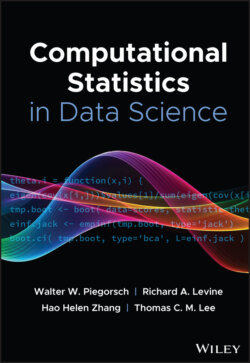Читать книгу Computational Statistics in Data Science - Группа авторов - Страница 31
1 User Development Environments
ОглавлениеWe begin by discussing user environments rather than focusing on specific statistical programming languages. The subsections below contain descriptions of some selected user development environments and related tools. This introductory material may be omitted if desired, and one can safely proceed to Section 2 for descriptions of the most popular statistical software.
Table 1 Summary of selected statistical software.
| Software | Open source | Classification | Style | Notes |
|---|---|---|---|---|
| Python | Y | Popular | Programming | Versatile, popular |
| R | Y | Popular | Programming | Academia/Industry, active community |
| SAS | N | Popular | Programming | Strong historical following |
| SPSS | N | Popular | GUI: menu, dialogs | Popular in scholarly work |
| C++ | Y | Notable | Programming | Fast, low‐level |
| Excel | N | Notable | GUI: menu, dialogs | Simple, works well for rectangular data |
| GNU Octave | Y | Notable | Mixed | Open source counterpart to MATLAB |
| Java | Y | Notable | Programming | Cross‐platform, portable |
| JavaScript, Typescript | Y | Notable | Programming | Popular, cross‐platform |
| Maple | N | Notable | Mixed | Academia, algebraic manipulation |
| MATLAB | N | Notable | Mixed | Speedy, popular among engineers |
| Minitab | N | Notable | GUI: menu, dialogs | Suitable for teaching and simple analysis |
| SQL | Y | Notable | Programming | Necessary tool for databases |
| Stata | N | Notable | GUI: menu, dialogs | Popular in scholary works |
| Tableau | N | Notable | GUI: menu, dialogs | Popular for business analytics |
| Julia | Y | Promising | Programming | Speedy, underdeveloped |
| Scala | Y | Promising | Programming | Typed version of Java, less boilerplate code |
Table 2 Summary of selected user environments/workflows.
| Software | Virtual environment | Multiple languages | Remote integration | Notes |
|---|---|---|---|---|
| Emacs, Vim | N | Y | Y | Extensible, steep learning curve |
| Jupyter project | Y | Y | Y | Open source, interactive data science |
| RStudio | Y | Y | Y | Excellent at creating reproducible reports/docs |
